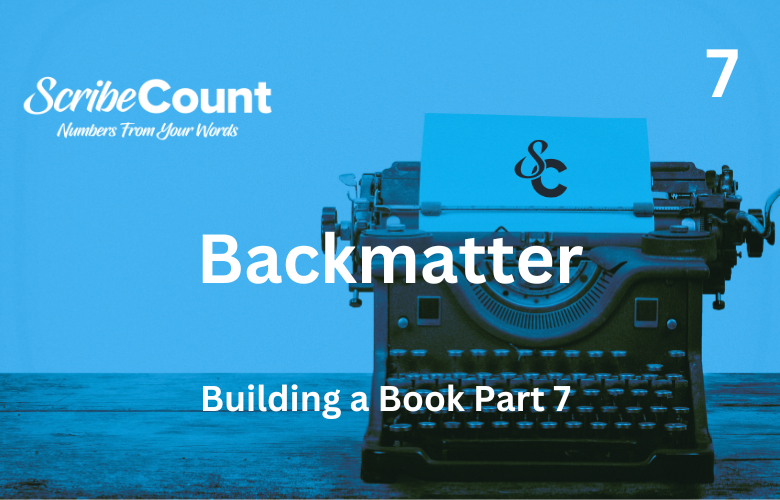The Backmatter of a Self-Published Novel: A Comprehensive Guide for Indie Authors
In the world of self-publishing, the backmatter of a book holds significant importance, not only as a tool for providing additional information or clarification but also as a marketing strategy. For indie authors, the backmatter serves multiple functions: enhancing the reader's experience, promoting future works, and increasing sales. In this article, we will explore the different sections that make up the backmatter, how indie authors can use them to their advantage, and the limitations they may face when publishing on platforms like Amazon, IngramSpark, and other self-publishing stores. Additionally, we’ll discuss how backmatter can be used strategically to market a series and maximize revenue.
Afterword: Reflection and Connection
An afterword typically comes at the very end of a book, just before any appendices or author bio. It serves as a space for the author to reflect on the journey of writing the novel, share insights into the creative process, or provide commentary on themes explored in the work. It is distinct from a foreword, which is written by someone else, often before the book's content begins.
For indie authors, an afterword can be a tool to directly address readers, express gratitude, or provide context that was left out of the main narrative. It is also an opportunity to add an element of personal touch that strengthens the connection with readers. While the afterword is primarily a personal reflection, authors should remember that it can also function as a subtle promotional tool. Authors can include teasers or brief mentions of upcoming works or projects in their afterwords. This helps build excitement for future releases and keeps readers engaged with their brand.
Appendix or Addendum: Additional Information and Resources
An appendix or addendum is an optional section at the back of the book where additional, relevant information is provided that didn’t fit into the main narrative. For fiction writers, this could include maps, glossaries, or explanations of historical references. For nonfiction, appendices may contain research, charts, or data that readers may find useful but that would disrupt the flow of the main content if included earlier.
Indie authors of speculative fiction, historical fiction, or other genres with complex worlds may find an appendix particularly useful. It allows them to go deeper into world-building, character backstories, or settings without overloading the narrative. For example, a fantasy author could use an appendix to offer a detailed map of their fictional world or provide a guide to the mystical creatures in the book.
While the appendix is not essential, it provides a professional touch that can elevate the reader’s experience, especially for readers who like to immerse themselves in the full scope of a world or story.
Endnotes: Clarification and References
Endnotes are typically used to clarify information or provide citations and references that are not included within the text itself. While more common in nonfiction, some indie authors choose to include endnotes in their fiction books to provide extra context, such as references to historical events, real-world facts, or language translations that would disrupt the flow of the story.
For indie authors, endnotes can serve as a subtle way to further engage readers with the content. By offering additional commentary or referencing sources that inspired certain parts of the book, authors deepen the reader's connection to the story. However, it’s important for authors to use endnotes sparingly, as they can be a distraction if overused in a work of fiction.
Bibliography: A List of Works Cited or Recommended
A bibliography is a comprehensive list of sources, books, articles, or other works that were referenced or inspired the content of the book. This is especially useful in nonfiction but can also apply to fiction if the author drew heavily from research or other literary works. The bibliography helps to lend credibility to the work, especially if it deals with factual information, historical events, or academic topics.
Indie authors writing historical fiction or creating fantasy worlds based on mythological research can use a bibliography to share the sources of their inspiration. This section helps readers to further explore the topics touched upon in the book, creating a broader engagement with the subject matter. For readers who are interested in learning more, the bibliography provides them with a roadmap to dive deeper into related topics.
Author Bio: Personal Connection with the Reader
The author bio is a standard feature in most books' backmatter. It provides readers with background information on the author, including their credentials, other works, and personal details that might interest readers. Indie authors should use the author bio as an opportunity to build a personal connection with their audience. This is especially important for those readers who have enjoyed the book and want to know more about the person behind it.
A compelling author bio helps create a sense of community around the author’s brand. It can include details about the author’s inspiration for writing, any other works they have written (with links), and perhaps some personal anecdotes or achievements. The author bio is often paired with a photo of the author, which adds a human element and makes the interaction feel more personal.
For indie authors, an effective author bio is also an opportunity to promote other works. Including a mention of the author’s website, social media profiles, or mailing list is a smart move, as it directs readers toward further engagement with the author’s work. A well-crafted bio can turn a one-time reader into a long-term fan.
Coming Soon/Read More: Building Anticipation for Future Works
One of the most powerful ways indie authors can use the backmatter to their advantage is by including a “Coming Soon” or “Read More” section. This section is often placed right after the author bio and is designed to build anticipation for upcoming books or works in progress. By offering a sneak peek into the next book in the series or highlighting a new project the author is working on, this section can keep readers excited about future releases.
Including a preview of the next book in the series is particularly effective for authors writing trilogies or multi-book series. A well-crafted teaser can create enough interest to ensure that readers will go directly to the author’s next book upon finishing the current one. This “read more” section is often paired with a link to the next book’s sales page, making it easier for readers to continue the journey without any friction.
Also By: Promoting Other Works
The “Also By” section is a simple, yet highly effective, tool for indie authors to promote their other books. It typically lists the author’s other works, especially if they are part of a series or written in the same genre. This section can be incredibly valuable for building a loyal readership, as it provides readers with easy access to more of the author’s work. The more books an author has, the more this section will help increase sales across their entire catalog.
For indie authors with multiple titles, the “Also By” section is crucial for expanding their reader base. Including direct links to other books, along with enticing descriptions or teasers, can drive readers to buy multiple works in a series or different titles from the author’s catalog.
Using Backmatter to Promote a Series
Indie authors can use the backmatter of their books as a powerful tool to promote their series. Including excerpts from the next book in the series or a “Coming Soon” section keeps readers hooked and eager to continue reading. By placing a sample of the next book in the series at the end of the current book, authors give readers a taste of what’s to come and encourage them to purchase the next installment immediately.
Including links to sales pages in the backmatter is crucial for driving sales. For example, an indie author could include a link to the sales page of the next book in their series, along with a call-to-action like “Continue the Adventure” or “Don’t Miss the Next Chapter!” This makes it easier for readers to make an immediate purchase and keeps the momentum going.
Smart Links: Driving Readers to Your Online Store
One of the most valuable aspects of indie publishing is the ability to retain control over your sales and profits. Many indie authors use smart links in the backmatter to direct readers to their own online stores. This allows authors to keep a higher percentage of the profits from each sale, compared to traditional marketplaces like Amazon, which typically take a significant cut.
Smart links are also useful for capturing readers’ attention on social media platforms or in email marketing campaigns. By providing readers with a convenient link to purchase directly from the author’s website, indie authors can not only boost their profit margins but also gain a valuable opportunity to add the reader to their mailing list.
Limitations of Backmatter on Self-Publishing Platforms
While backmatter is a powerful tool for indie authors, it’s important to be aware of the limitations when using popular self-publishing platforms such as Amazon and IngramSpark. For instance, Amazon’s KDP platform places restrictions on the types of content that can appear in backmatter, particularly with regard to promotional links. Authors are not allowed to include direct links to external stores, and there are guidelines about what content can be included in the backmatter.
Additionally, platforms like KDP have strict rules about offering content outside of the ebook's core narrative, so authors need to be mindful of these guidelines when adding promotional material. To circumvent these restrictions, authors may need to create platform-specific versions of their books that are tailored to each platform’s rules and limits.
Creating Platform-Specific Versions
Because of the limitations imposed by different platforms, indie authors often need to create separate versions of their books for each platform. For example, a version for Amazon might not include external sales links, while a version for the author's own website could include those links. Authors should carefully review the backmatter requirements for each platform they publish on and ensure they’re in compliance while still optimizing their content for marketing.
Conclusion
The backmatter of a self-published novel is an essential component that serves both functional and promotional purposes. By carefully crafting sections like the afterword, appendix, bibliography, and author bio, indie authors can deepen their connection with readers and pave the way for future sales. Including promotional elements like “Also By” and “Coming Soon” sections ensures that readers stay engaged with the author’s work. However, authors must also be mindful of the limitations posed by major platforms like Amazon and adapt their backmatter to suit each store's rules. By strategically using the backmatter, indie authors can promote their series, increase their sales, and grow their readership effectively.

